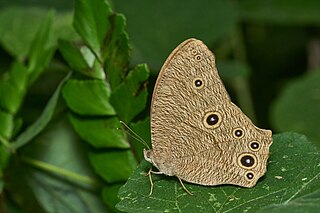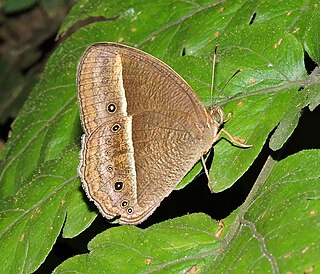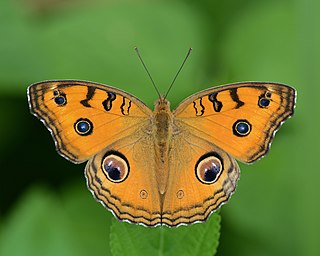
Mycalesis anaxias, the white-bar bushbrown, is a species of satyrid butterfly found in South and Southeast Asia. In South Asia, it inhabits Sikkim, eastwards through the hill-ranges to Assam, Cachar, Myanmar and Tenasserim. Also in southern India, in the Nilgiris and Travancore.

Melanitis leda, the common evening brown, is a common species of butterfly found flying at dusk. The flight of this species is erratic. They are found in Africa, South Asia and South-east Asia extending to parts of Australia.

Dodona ouida, the mixed Punch, is a small but striking butterfly found in the Indomalayan realm in West China, Himalayas, Northeast India (hills) and Burma that belongs to the Punches and Judies, that is, the family Riodinidae.

Colotis fausta, the large salmon Arab, is a small butterfly of the family Pieridae, that is, the yellows and whites, which is found in Israel, Syria, Turkey, Iran, Afghanistan, Turkmenistan, India, Arabia, Chad, Somalia and United Arab Emirates.

Mycalesis perseus, the dingy bushbrown or common bushbrown, is a species of satyrine butterfly found in south Asia and southeast Asia.

Junonia hierta, the yellow pansy, is a species of nymphalid butterfly found in the Palaeotropics. It is usually seen in open scrub and grassland habitats.

Zipaetis saitis, the Tamil catseye, is a species of nymphalid butterfly found in South India.

Kaniska canace, the blue admiral, is a nymphalid butterfly, the only species of the genus Kaniska. It is found in south and southeast Asia.

Mycalesis mineus, the dark-brand bush brown, is a species of satyrine butterfly found in Asia.

Mycalesis subdita, the Tamil bushbrown, is a satyrine butterfly found in south India and Sri Lanka. It is not resolved whether this is a good species or is a subspecies of Mycalesis visala.

Heteropsis adolphei, the red-eye bushbrown, is a species of satyrine butterfly found in southern India. The species name is after Adolphe Delessert who collected the first specimens based on which the species was described.

Mycalesis mestra, the white-edged bushbrown, is a species of satyrine butterfly found in Asia

Mycalesis nicotia, the brighteye bushbrown, is a species of satyrine butterfly found in Asia.

Prosotas noreia, the white-tipped lineblue, is a species of lycaenid butterfly found in South Asia and Java.

Junonia almana, the peacock pansy, is a species of nymphalid butterfly found in Cambodia and South Asia. It exists in two distinct adult forms, which differ chiefly in the patterns on the underside of the wings; the dry-season form has few markings, while the wet-season form has additional eyespots and lines. It is listed as Least Concern in the IUCN Red List.

Ypthima baldus, the common five-ring, is a species of Satyrinae butterfly found in Asia.

Ypthima huebneri, the common fourring, is a species of Satyrinae butterfly found in Asia.

Vindula erota, the common cruiser, is a species of nymphalid butterfly found in forested areas of tropical South Asia and Southeast Asia.

Junonia iphita, the chocolate pansy or chocolate soldier, is a butterfly found in Asia.

Ypthima striata, the Nilgiri jewel fourring or striated fivering, is a species of Satyrinae butterfly found in south India.





















